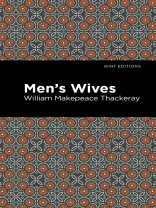Men’s Wives (1852) is a novel by William Makepeace Thackeray. Divided into three sections—“The Ravenswing”; “Mr. and Mrs. Frank Berry”; and “Dennis Haggarty’s Wife”—Men’s Wives satirizes the married lives of England’s elite.
In “Ravenswing, ” a novella, Captain Walker meets a beautiful young woman named Morgiana Crump. The daughter of an eccentric hotelier and a retired actress, Miss Crump is being prepared for marriage by her overeager parents. Struggling to compete with the countless suitors constantly crowding Miss Crump, Walker, an officer and a gentlemen, grows progressively disheartened. “Mr. and Mrs. Frank Berry” is a two-part story following one man from youth to adulthood. A fighter in his schoolboy days, Mr. Frank Berry is now a married man. When a chance encounter in Versailles reunites him with some old friends, however, his wife begins to fear that her husband is not yet ready to settle down. “Dennis Haggarty’s Wife” is a short story tracing the journey from repulsion to marriage between a snobbish protestant Irishwoman and the Irishman she marries despite his Catholic heritage. Throughout Men’s Wives, a humorous collection of stories on marriages mostly disastrous, Thackeray effectively satirizes the lives and loves of his nation’s elite.
This edition of William Makepeace Thackeray’s Men’s Wives is a classic of English literature reimagined for modern readers.
Since our inception in 2020, Mint Editions has kept sustainability and innovation at the forefront of our mission. Each and every Mint Edition title gets a fresh, professionally typeset manuscript and a dazzling new cover, all while maintaining the integrity of the original book.
With thousands of titles in our collection, we aim to spotlight diverse public domain works to help them find modern audiences. Mint Editions celebrates a breadth of literary works, curated from both canonical and overlooked classics from writers around the globe.
Sobre o autor
William Makepeace Thackeray (1811-1863) was an English novelist, satirist, and illustrator. Born in India, Thackeray was sent to England by his mother at the age of four following the death of his father, a secretary for the East India Company. Educated at the Charterhouse School, a boarding school in Godalming, Surrey, Thackeray went on to study at Trinity College, Cambridge before abandoning academia in 1830. He spent the next few years traveling throughout Europe, visiting Paris and meeting the elderly Goethe in Weimar. In 1836, after squandering much of his inheritance on gambling and ill-advised investments, Thackeray at last settled down, marrying Isabella Gethin Shawe and embarking on a career as a professional writer. During this period, he contributed regularly to Fraser’s Magazine, The Times, The Morning Chronicle, and Punch, while also publishing Catherine (1840) and The Luck of Barry Lyndon (1844), his first full length works of fiction. Despite his newfound success, however, these years were tragically marred by the decline of Thackeray’s wife, who suffered from a debilitative case of postpartum depression that led to her institutionalization. Between 1845 and 1851, under the pseudonym Hibernis Hibernior, Thackeray produced illustrations in Punch that are now recognized as hostile to the Irish people and exploitative of their suffering during the Great Irish Famine. In 1848, Thackeray published Vanity Fair, a satirical novel examining the lives of England’s elite during and after the Napoleonic Wars.












